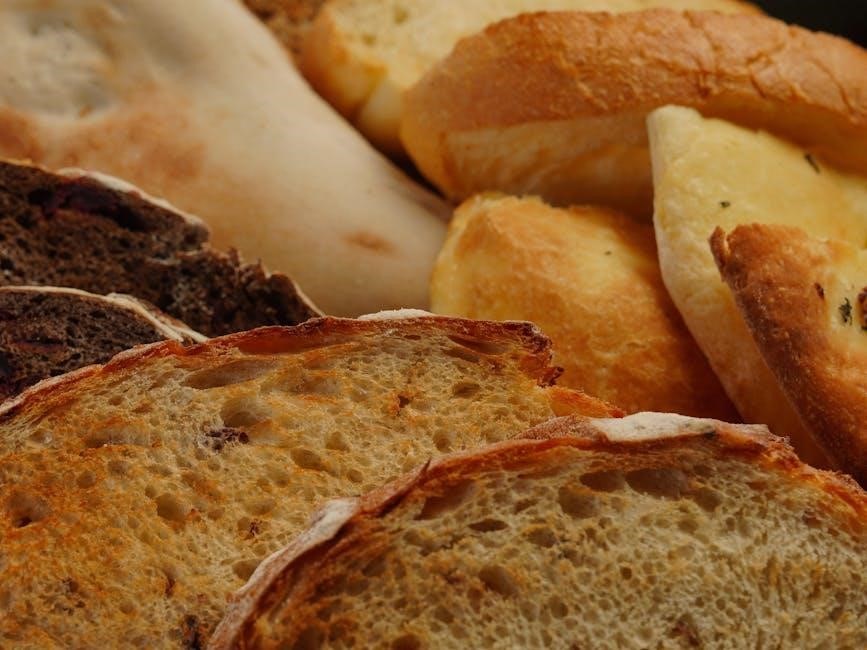
Paris Baguette Nutrition: An Overview
Paris Baguette offers a delightful array of baked goods. Understanding the nutritional content is key. This overview aims to guide you through the available nutrition information. It helps to make informed choices about their menu items.
Understanding Nutritional Information Availability
Navigating the nutritional information for Paris Baguette can be a bit tricky. While a centralized, downloadable PDF isn’t readily available, there are alternative resources to explore. Start by checking their official website for any dedicated nutrition pages. You can often find details about calories, fats, carbohydrates, and protein for various menu items, including pastries, sandwiches, and beverages.
Many third-party websites and apps dedicated to tracking calories and nutrition also feature data on Paris Baguette products. However, always verify the accuracy of information obtained from unofficial sources. It’s also helpful to inquire directly at your local Paris Baguette. Staff members might have access to detailed nutritional information or be able to provide insights.
Key Menu Items and Their Nutritional Content
Exploring the nutritional content of key Paris Baguette items such as baguettes, pastries, and sandwiches is essential. This section breaks down calories and macronutrients for informed choices.
Baguettes: Calorie and Macronutrient Breakdown
Paris Baguette’s signature baguettes are a popular choice, but understanding their nutritional profile is important. A single serving of a baguette contains approximately 110 calories. The macronutrient breakdown consists primarily of carbohydrates, with smaller amounts of protein and fat.
Specifically, a baguette provides around 24 grams of carbohydrates, 4 grams of protein, and 15 grams of fat. This makes it a carbohydrate-rich option.
These values can vary slightly depending on the specific type of baguette. Whether it’s a plain baguette or one with added ingredients. Considering these details allows for informed dietary decisions. Baguettes can be part of a balanced diet when consumed in moderation.
Pastries: Calorie and Macronutrient Breakdown
Paris Baguette offers a wide variety of pastries. Each pastry varies significantly in calorie and macronutrient content. For instance, a Chocolate Croissant contains roughly 230 calories per serving. The macronutrient breakdown includes carbohydrates, fats, and protein.
Other pastries, like the Fruit Pastry, have a different profile. The Pastel De Nata contains around 140 calories. These values depend on ingredients like butter, sugar, and fillings.
Knowing this information helps customers make informed choices. Some pastries are higher in fat and sugar. Always consider portion sizes when indulging in these treats. Balancing your diet with these considerations is vital for health.
Sandwiches and Salads: Calorie and Macronutrient Breakdown
Paris Baguette’s sandwiches and salads offer a range of nutritional options. The Turkey Avocado Sandwich includes turkey, avocado, tomato, cucumber, mixed greens, and honey mustard on multigrain bread. The nutritional breakdown includes calories, protein, fats, and carbohydrates.
Salads typically contain fewer calories. The exact amount depends on the ingredients and dressings used. For example, a salad with vinaigrette will differ from one with creamy dressing.
The Ham Baguette is a popular choice. Consider the balance of protein, carbs, and fats in your meal. Reviewing the nutritional information helps to choose healthier options. Making informed decisions supports a balanced diet while enjoying Paris Baguette.

Specific Product Nutrition Details
Delving into the specifics, this section provides detailed nutrition for individual Paris Baguette items. From Milk Bread to Strawberry Soft Cream Cake and Croissants, find precise calorie and macronutrient information here.
Milk Bread Nutrition Information
Paris Baguette’s Milk Bread is a popular choice. Each slice contains approximately 120 calories. It also features 3.5 grams of fat, 19 grams of carbohydrates, and 3 grams of protein. This makes it a relatively light option among their offerings. Considering these values can help you integrate it into your daily caloric and macronutrient goals. The soft texture and subtle sweetness make it a comforting treat. However, being mindful of portion sizes is essential for balanced nutrition. Enjoying it as part of a varied diet allows for both satisfaction and health consciousness. Remember to factor in any spreads or toppings you might add, as these will contribute to the overall nutritional profile.
Strawberry Soft Cream Cake Nutrition Information
A serving of Paris Baguette’s Strawberry Soft Cream Cake contains about 300 calories. The breakdown includes 22 grams of carbohydrates, 21 grams of fat, and 3 grams of protein. This dessert is relatively high in fat due to the creamy component. It is moderately high in sugar from both the cake and the strawberry elements. This treat is best enjoyed in moderation. It should be considered as an occasional indulgence rather than a regular dietary staple. Balancing it with nutrient-dense foods is key to maintaining a healthy eating pattern. Consider sharing a slice to reduce your individual intake of calories, fat, and sugar. Always factor in desserts when planning your daily nutritional goals.
Croissant Nutrition Information
A single Paris Baguette croissant typically contains around 250 calories. The macronutrient composition includes approximately 24 grams of carbohydrates, 15 grams of fat, and 4 grams of protein. Croissants are known for their buttery and flaky texture. This contributes to their higher fat content. They are a popular pastry choice, but should be consumed in moderation. Due to their caloric density and fat content, croissants are best enjoyed as an occasional treat. Consider pairing it with a lighter meal or snack. This helps balance your overall calorie and macronutrient intake. Always be mindful of portion sizes to manage your nutritional intake effectively.
Comparing Paris Baguette to Other Bakeries
When comparing Paris Baguette to other bakeries, nutritional values vary. Factors include ingredients, serving sizes, and preparation methods. Comparing helps consumers make informed dietary decisions.
Tous Les Jours Nutritional Information Comparison
Comparing Paris Baguette to Tous Les Jours reveals key nutritional differences. Tous Les Jours, another French-Asian bakery, offers varied items. Their nutritional information is essential for comparison. For instance, Tous Les Jours provides data on energy, protein, fat, and carbohydrates per serving. Similar to Paris Baguette, Tous Les Jours offers croissants and pastries. However, their recipes and ingredients may differ. This leads to variations in calorie counts and macronutrient breakdowns.
Analyzing these differences allows consumers to make informed decisions. Consider the Chocolate Croissant; each bakery’s version has unique nutritional profiles. Accessing and comparing this data supports healthier choices. Understanding these nuances helps individuals align their bakery selections with dietary goals. Both bakeries aim to provide delicious options while catering to nutritional awareness.

Accessing Nutrition Information
Finding nutritional details for Paris Baguette is crucial. Online resources offer some data on calories and macronutrients. Explore their website and food databases for comprehensive information to make informed choices.
Online Resources for Nutritional Data
Several online platforms can assist in finding Paris Baguette’s nutritional information. While a centralized PDF might be elusive, websites often provide details on popular items like the Baguette, Iced Matcha Latte, and pastries. Calorie counts, macronutrient breakdowns (fat, carbs, protein), and allergen information are frequently available. Sites such as MyFitnessPal or other food databases sometimes have user-submitted data.
Be aware that accuracy can vary. Official sources, when available, are preferable. Exploring multiple resources and comparing information will help you get a more accurate understanding. Keep in mind that recipes can change, so information might not always be completely up-to-date. Always check for the most current details.

Understanding Daily Values
Daily Values (DV) indicate how much a nutrient contributes to a daily diet. They are based on a 2,000-calorie diet. Use DVs as a guide to balance your choices from Paris Baguette.
How Daily Values Relate to Paris Baguette Menu Items
Understanding Daily Values (DVs) is crucial when considering Paris Baguette menu items. DVs, based on a 2,000-calorie diet, help you assess how much a serving contributes to your daily nutritional needs. For instance, the Daily Value tells you how much a nutrient in a serving of food contributes to a daily diet.
When examining the nutritional information for items like the Milk Bread, Strawberry Soft Cream Cake, or Croissant, pay attention to the percentage of DVs for nutrients like fat, carbohydrates, and protein. This allows you to make informed choices aligned with your dietary goals.
Consider a croissant with 250 calories, 24g carbs, 15g fat, and 4g protein. Comparing these values to your DVs helps you manage your overall intake.
Allergen Information
For those with dietary restrictions, allergen information is crucial. Paris Baguette’s products often contain common allergens. These allergens include wheat, milk, eggs, soy, tree nuts (like almond, coconut). Always inquire about ingredients.
Common Allergens in Paris Baguette Products
Navigating allergen information at Paris Baguette is vital for individuals with sensitivities. Key allergens present in many items include wheat, a primary ingredient in breads and pastries. Milk is another frequent allergen, found in creams, fillings, and some doughs. Eggs are also commonly used in various baked goods, contributing to texture and richness. Soy is often present in processed ingredients and chocolate components. Tree nuts, like almonds and coconuts, can be found in toppings, fillings, and certain pastries. Cross-contamination is a potential risk in a bakery setting. Always confirm ingredient details with staff. Review product labels carefully. Prioritize your health by making informed choices. Stay vigilant and enjoy your treats safely.

Finding PDF Resources (Challenges and Alternatives)
Finding a centralized PDF nutrition guide for Paris Baguette can be challenging. Explore online resources and individual product details as alternatives. Consider contacting Paris Baguette directly for comprehensive allergen and nutrition information.
Availability of a Centralized PDF Nutrition Guide
Currently, a readily available, centralized PDF nutrition guide for Paris Baguette is not easily found online. This absence can make accessing comprehensive nutritional information about their products more difficult. Customers often seek such a resource for convenient offline access.
The lack of a PDF guide necessitates exploring alternative methods for obtaining nutritional details. These methods include browsing the Paris Baguette website. You can also check third-party nutrition databases. Additionally, directly contacting Paris Baguette’s customer service may provide specific nutritional data.
Despite the convenience of a PDF, online resources offer frequently updated information. Product formulations and nutritional values evolve. Staying informed requires checking multiple sources. This ensures you have the most current and accurate data available.